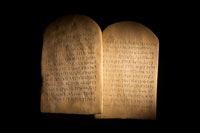 Right now, since you are on the internet, search for a picture of the Ten Commandments. Go ahead. Try it. If you do you will find that most pictures depict the Ten Commandments on two tablets of stone—five on each tablet.
Right now, since you are on the internet, search for a picture of the Ten Commandments. Go ahead. Try it. If you do you will find that most pictures depict the Ten Commandments on two tablets of stone—five on each tablet.
Two Copies of the Ten Commandments
However, the two tablets of God’s covenant which Moses brought down from Mt. Sinai to the people were probably two copies—the full Ten Commandments on each tablet. “So what!” you say? The significance of two copies of the Ten Commandments lies in the fact that the Ten Commandments were a concise summary of the covenant God entered at Mt. Sinai between Himself and His people. Remember God was creating a people for his very own possession. He rescued them, redeemed them, provided for them, and protected them as we saw in the last post. Now it was the people’s turn to respond and be His treasured possession, representing Him to all the nations. That was the contractual agreement (Exodus 19:6). The list of the Ten Commandments in Exodus 20:1-22 is the summary of that agreement between Yahweh and His people.
In most contractual agreements in our society, each party gets a copy. This was no different in the ancient times as well. The covenant between God and Israel seems to be in the form of an ancient treaty between a king and his vassals (servant people) that was common among the nations during the time of Moses. Each party of the contract would obtain a copy and store it in a sacred location before their so-called gods. The deposit of the text in a sacred place before their deities signified that no word of the contract could ever be added or taken away, and that the deities would be a witness if the covenant were ever broken. The tablets referred to in Exodus 32:15-16 were probably two contractual “witnesses” for each party—one for God and one for His people.
One Amazing God
The greatest and most amazing difference, however, between God’s covenant with His people and the ancient despotic kings with their servants is in the location of where the covenant was deposited. The copies of the contractual agreement between the one true God and His vassals were deposited in a sacred place—the Ark of the Covenant. The lid of the Ark of the Covenant was called the “Mercy Seat,” where atoning blood was sprinkled and above which God’s physical presence dwelled (Exodus 25:21-22).
The amazing grace of God is demonstrated in a profound way in this set up. The contractual agreement between God and His people that formed the basis of their relationship would never be seen by God apart from the atoning blood sprinkled on the Mercy Seat. Yahweh knew His people would inevitably break the stipulations of the covenant and He provided a way to continue dwelling with His people despite the broken covenant—through the blood of the covenant.
Oh the mercy and grace of God! And you know this was all to prefigure something greater about God’s mercy in Jesus Christ. Try reading Hebrews 9:11-28 right now and be amazed!
 Church
Church